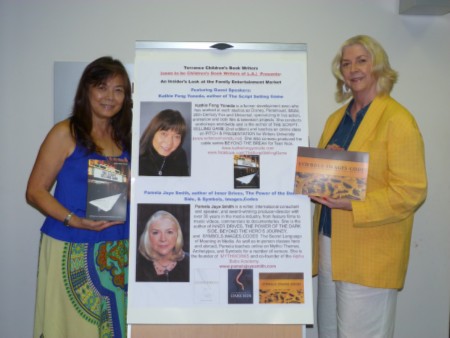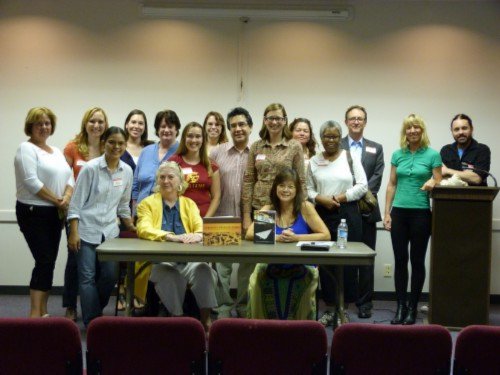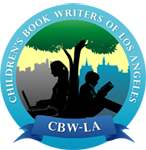I first met our wonderful speakers Pamela Jaye Smith and Kathie Fong-Yoneda at a book signing in Barnes & Noble, Santa Monica on June 28, 2011. I listened to them, and two other script-writing consultants talk about Screenwriting, and writing in general.
At the end of their talk, I lined up to get copies of their books signed. They asked me about my own writing, and I told them about the writing group for children’s books writers that I had founded last year. Kathie was most interested, and when she heard that we were always looking for speakers who would teach us for free (since we didn’t exactly have the funds), she immediately offered to be a speaker.
Lena and I had taken pictures at the event, and so we emailed to them a week later. I was thrilled when Kathie said that she was coming down to L.A. sometime in August and she had some free time to maybe come speak to our group. She even got Pamela Jaye Smith to agree to be a speaker as well.

Kathie Fong-Yoneda & Pamela Jaye Smith, with a poster of our event
The event was held at the Torrance Municipal Airport meeting room from 7-9PM.
Torrance Municipal Airport Zamperini Field - General Administration Building
Thanks to Lena, Lucy and Tiffani’s help, we got the room all set up before the speakers and our fellow writers arrived. One of our members, Jeff, was kind enough to bring some coffee in case anybody needed it for a quick boost.
Kathie and Pamela arrived early, and even gave us some cookies from King’s Hawaiian to add to the snacks we were providing for everyone.
We waited a few minutes until everybody had signed in, gotten their name tags and chosen their seats; then I introduced our speakers.
Introducing the speakers
Kathie Fong Yoneda is a former development exec who has worked at such studios as Disney, Paramount, MGM, 20 thCentury Fox and Universal, specializing in live action, animation and both film & television projects. She conducts workshops worldwide and is the author of THE SCRIPT-SELLING GAME (2 nd edition) and teaches an online class on PITCH & PRESENTATION for Writers University (www.writersuniversity.net). She also co-exec produced the cable series BEYOND THE BREAK for Teen Nick.
www.kathiefongyoneda.com & www.facebook.com/TheScriptSellingGame
Pamela Jaye Smith is a writer, international consultant and speaker, and award-winning producer-director with over 30 years in the media industry, from feature films to music videos, commercials to documentaries. She is the author of INNER DRIVES, THE POWER OF THE DARK SIDE, BEYOND THE HERO’S JOURNEY, and SYMBOLS.IMAGES.CODES: The Secret Language of Meaning in Media. As well as in-person classes here and abroad, Pamela teaches online on Mythic Themes, Archetypes, and Symbols for a number of venues. She is the founder of MYTHWORKS and co-founder of the Alpha Babe Academy.
www.pamelajayesmith.com
Kathie began her talk by telling everyone the story of how we had first met, and of how they had come to be our speakers. She also told us of how she and Pamela have been friends for years, and of how they work together often on certain projects.
Kathie gave us an inside peek into how family projects are acquired. First, she answered the question, “What is the family entertainment market?”
Family entertainment, Kathie says, consists of feature films, games, books and web-based projects, although every day technology comes up with some other new way for us to enjoy the art of story telling.
Based on her years as Disney executive, Kathie has come up with several answers as to what makes family entertainment so popular.
1. There is an understanding that children don’t necessarily have to take center stage.
2. Kids like to see funny, outrageous, out of control or scary situations are popular
3. Most publishers and studios like projects that appeal to the entire family, and not just to kids that are under 10 years old.
4. Projects Need to have Cross-Over appeal.
Another question that Kathie often gets asked is, What kinds of projects attract a buyer?
Kathie listed down the most popular kinds of projects, along with examples of movies in each genre.
Comedies – Home Alone, Night at the Museum
Comedies that have a positive message – Shrek, Toy Story, Up
Dramas that have some kind of action/magical supernatural elements – twilight, Harry potter, spiderman
Dramas that have universal themes – lion king, mulan
Action –Adventure – Indiana Jones, M.I.B, National Treasure
One of the most important questions that Kathie answered that night was How can a writer get his/her work noticed?
Kathie says that over 80% of Oscar-nominated films for BEST PICTURE are adaptations. Almost 45% of all TV & cable movies are adaptations. Of those 70% of all Emmy Award winners for TV & cable movies are from adaptations.
Still most books are not meant to become movies.
Studios & networks take a hard look at making films based on books because they have to pay twice as much – once for the book & once for the screenplay.
Kathie then gave us a list of things we should consider if we wanted to use this strategy.
Aside from teaching us about loglines, Kathie also gave us a list of things the producer or studio would need to know if we were to submit a synopsis:
- ·Who is the hero/heroine?
- ·What is his/her goal?
- ·What is the issue, problem or challenge he/she faces?
- ·Where does a majority of the story take place?
- ·What is the time span involved?
- ·Does it take place in the past, future or present?
Kathie reminded us that studios always look for stories that have one or more of the following elements:
I realized that story elements studios and producers of film look for in projects they receive, are the same elements that publishers look for in the stories submitted to them.
Kathie also listed down some major challenges in adapting our books into screenplays. Some of these challenges include the fact that many books span a large chunk of time, and while the main storyline is usually apparent in a book, many writers want to “remain true” to their work by keeping in too many subplots or characters.
This is possibly why novelists can’t write screenplays, the same way most screenwriters can’t write novels.
She said writers and their formats are like athletes and their sport. You may be good in golf, but you may be crummy in skiing. Or you may do well in track, but you can’t swim. Sometimes you can do well in 2 or 3 kinds of sports, same as writing.
Kathie ended her talk by giving us other advice for submitting our works to a publisher or studio. She says we should keep in mind that once a studio buys the rights to our book or manuscript, they “own” it & we no longer have control over the subsequent adaptation that results from their purchase.
Kathie ended her talk to a loud applause, and we entered the second phase of our event:
Pamela Jaye Smith's talk: Symbols and the Dark Side in Family Entertainment, Yes You Need It.
Pamela started her talk by asking us to imagine a pie chart for our story. Within that pie chart, there are three elements that we should consider to make our stories good:
Enlightenment
Entertainment
Expression
Pamela explained that we should ask ourselves what the ratio of these elements is in the story we’re writing.
Enlightenment is art, which shows us some kind of different vision. This is something our stories need, after all, Pamela reminded us, we don’t get much enlightenment from watching “Dumb and Dumber”.
Entertainment is the element that allows the audience to enjoy the story, while Expression is basically the part of the story that allows us to express ourselves.
Another important thing to remember is that writing is made up of Art, Craft and Business. Pamela said that Kathie did a great job of explaining the Business part, and so her task was to talk about the Art & Craft part.
Pamela went on to define mythology. She emphasized that a myth isn't a female moth undefined as one child once put it, but that myths are stories we tell ourselves to explain the world around us and within us.
She talked a little bit about human developmental ages. Each human developmental stage is related to the kind of stories people like to hear about at the different stages of their lives.
The first 7 years of our lives is devoted to learning about how to work our bodies. In the second 7 years of our lives, we learn about emotion. In the third 7 years of our lives, the focus is on our mental growth. The 4th 7 years of our lives is about combining all those elements.
For the most part, as children’s book writers we work on the first and second 7 years and so our stories are mostly about the physical and the emotional.
One thing to remember is that idealism is part of what creates the magic that makes a book work. That’s why we have heroes, so that we could look up at something or someone. Heroes represent that enlightenment part of a story.
Stories with heroes have worked for thousands of years. One of the first books that Pamela remembers that she loved was Oscar Wilde’s fairytales. Most of the stories in that book are about good behavior for children, appropriate behavior for young adults and sacrificial behavior for adults to get to that greater good.
Lawrence of Arabia is one of those movies that Pamela said made a really big impression on her when she was younger. It wasn't a kid’s movie, but it was so idealistic undefined about a person going by themselves into a situation, and becomes a part of it, and adds and improves the situation by what he brings into it.
Pamela calls this the “Going Native” theme. And this is interesting for teens, particularly because teens think they are “the only one in the world who has ever felt like this.”
She also told us to keep in mind when we write our stories that kids’ brains are usually wired for empathy by age 5 undefined if they’re not, then we may have a psychopath on our hands. And that’s the value of puppies and cuddly things.
Pamela went on to explain that the way to make our characters grow and learn things in our stories is for them to encounter conflict undefined which she also calls the “dark side”.
There are 3 levels of the Dark Side, or three kinds of conflicts:
Personal
Impersonal
Supra-personal
Stories that are most effective are ones that use at least two of these three elements.
Pamela also listed down the 10 Aspects of Opposition and taught us how to select the best ones for our story.
1. Self
2. Other individuals
3. Family
4. Sweethearts & rivals
5. Religion
6. Environment
7. Technology
8. Wars - and warring factions.
9. Gods, monsters, magic, demons, and aliens .
10. The Dark Brotherhood – the really big bad guys.
The 3 categories of Symbolism and how to coordinate your imagery
Emotional
Situational
Conceptual
Our two wonderful speakers spent a few more minutes answering the many questions about writing, publishing, symbolism, and conflict that our members asked them.

Before we lined up to get our books signed, we took a picture of our group with the fabulous speakers Kathie Fong-Yoneda and Pamela Jaye Smith.
Children's Book Writers with Authors & Speakers Pamela Jaye Smith and Kathie Fong Yoneda
The workshop was a definite success. Kathie and Pamela did a great job of challenging us to create better stories that will stand the test of time.





